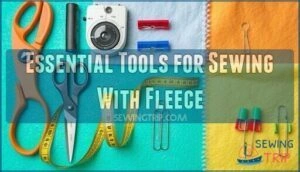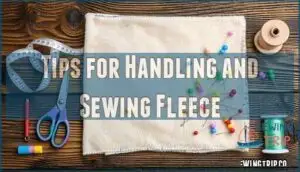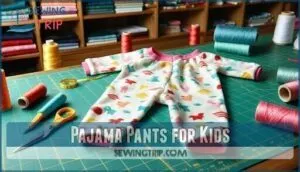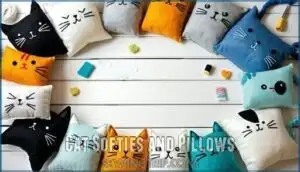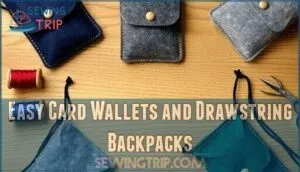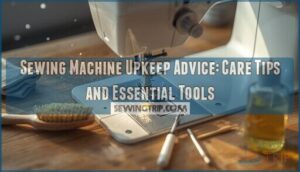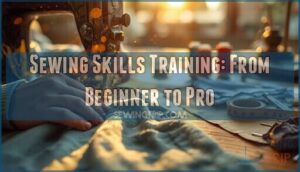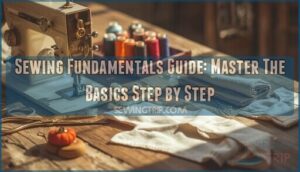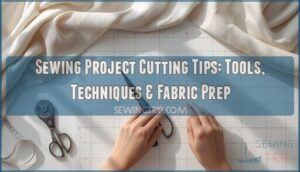This site is supported by our readers. We may earn a commission, at no cost to you, if you purchase through links.
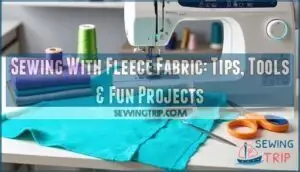 Fleece fabric forgives just about every sewing mistake you can make. The edges don’t fray when you cut them. The stretch hides wonky stitches. And if you accidentally sew something backward, you can usually rip it out and start over without leaving a trace.
Fleece fabric forgives just about every sewing mistake you can make. The edges don’t fray when you cut them. The stretch hides wonky stitches. And if you accidentally sew something backward, you can usually rip it out and start over without leaving a trace.
That’s why sewing with fleece fabric is perfect when you’re learning or when you need a quick project that actually works.
But fleece has quirks too. It stretches in weird directions. It sheds lint everywhere. And your sewing machine might fight you if you don’t adjust a few settings first.
Once you know how fleece behaves and which tools make the job easier, you’ll breeze through blankets, scarves, and cozy pajamas without the frustration.
Table Of Contents
Key Takeaways
- Fleece fabric is beginner-friendly because it doesn’t fray, stretches to hide imperfect stitches, and allows you to rip out mistakes without leaving visible marks—making it perfect for learning basic sewing techniques.
- Use a ballpoint or stretch needle (size 90/14), polyester thread, and a walking foot on your sewing machine to prevent skipped stitches, puckering, and fabric slippage when working with fleece’s stretchy texture.
- Prevent common fleece problems by cutting with the bias direction in mind, using fabric clips instead of pins, increasing seam allowances to 5/8 inch, and keeping a lint roller nearby to manage constant shedding.
- Wash fleece in cold water on a delicate cycle, skip fabric softeners entirely, and air dry flat instead of using high heat to maintain softness, prevent pilling, and avoid shrinkage over time.
Choosing The Best Fleece for Sewing
Not all fleece is created equal. The type you choose affects how easy your project is to sew and how well it holds up over time.
Let’s look at the different fleece options so you can pick the right one for your next creation.
Types of Fleece Fabrics
Fleece comes in more varieties than you might expect, and picking the right type can make or break your project. Polar fleece is your go-to workhorse—thick and warm with a brushed texture that’s perfect for blankets. Micro fleece feels lighter and smoother against skin, making it ideal for baby items. Sherpa fleece mimics wool with its bumpy pile, while coral fleece has a plush, velvety hand. French terry offers stretch and breathability for active wear. Each fabric brings different properties to your sewing table.
How to Select Quality Fleece
Knowing your fabric types is one thing, but spotting quality fleece when you’re standing in the fabric store takes a trained eye. Here’s what to check before you buy:
- Fiber Content: Look for 100% polyester or blends with natural fibers—check the bolt end for composition details that affect how your fabric behaves.
- Weight Matters: Quality fleece feels substantial without being stiff. Lightweight options work for scarves while heavier weights suit blankets.
- Pilling Resistance: Rub the surface vigorously with your fingers. Good fleece won’t form fuzzy balls immediately, making it more durable for sewing supplies investments.
- Colorfastness: Stretch a corner and check if color stays even—fading indicates poor dye quality that’ll frustrate beginner-friendly fabric selection.
Smart fabric choices mean your finished projects last longer and look better.
Eco-Friendly and Sustainable Fleece Options
Beyond choosing quality fabric, you can make sustainable sewing choices too. Recycled polyester fleece redirects about eight plastic bottles per meter from landfills and now represents a $2.1 billion market growing fast. Organic alternatives like bamboo or hemp-based fleece offer biodegradable options with smaller environmental footprints. Look for ethical certifications like GOTS or Bluesign that guarantee closed-loop systems and responsible production.
The market is expected to expand considerably, reaching $5.8 billion by 2033. Just remember—synthetic fleece sheds microfibers into waterways, so washing at lower temperatures helps reduce microfiber pollution while your upcycled materials stay cozy.
Essential Tools for Sewing With Fleece
Having the right tools makes sewing fleece easier and more enjoyable. The basics aren’t hard to figure out, but some specific gear helps you work with this stretchy fabric without pulling your hair out.
Let’s look at what you need to have on hand before you start your first fleece project.
Recommended Sewing Machines and Settings
Your sewing machine needs serious muscle to manage fleece without throwing a fit. Machine piercing power matters most when you’re working through multiple layers. The Janome HD5000 Black Edition and Singer Heavy Duty 4411 both tackle thick fleece like champs.
Look for features like adjustable presser foot tension and a top-loading bobbin system for quick fixes. Set your stitch length guide to 3.5–4 mm for straight seams. Considering mechanical machines’ durability is helpful when choosing a machine for tough fabrics.
Remember that fleece lint buildup happens fast, so regular sewing machine maintenance keeps everything running smoothly.
Best Needles and Threads for Fleece
Picking the wrong needle for fleece is like trying to cut steak with a butter knife—frustrating and messy. Your sewing machine needs a ballpoint or stretch needle in size 90/14 to glide through fleece without snagging. Match your thread weight to your fabric—polyester thread works best because it has the right fiber content and won’t snap under tension.
Here’s what you need:
- Needle types: Ballpoint (size 90/14) prevents runs and holes in knit fleece
- Thread weight: All-purpose polyester in 40-50 weight withstands stretch without breaking
- Color matching: Choose thread one shade darker than your fabric for invisible seams
Cutting Tools and Techniques
Sharp fabric shears are your best friend when cutting fleece—dull blades turn clean edges into fuzzy disasters. For accurate cutting, mark with tailor’s chalk and cut in one smooth motion. Fabric scissors work fine for small projects, but pinking shears help prevent fraying on raw edges.
Use rotary cutters with cutting mats for straight lines and curves without wrestling thick layers.
Pattern weights keep fleece flat better than pins (which leave holes).
Must-Have Notions and Accessories
A few small tools can make the difference between wrestling with fleece and breezing through your project like a pro. Grab a walking foot to feed thick fleece evenly through your machine. Fabric weights hold slippery material better than pins.
Keep a point turner handy for crisp corners and a bodkin for threading drawstrings. A measuring tape rounds out your essential sewing tools kit. These sewing supplies turn tricky fleece into your favorite fabric to work with.
Tips for Handling and Sewing Fleece
Fleece is soft and forgiving, but it has a mind of its own. It can stretch, shed, and slip around on your sewing table if you’re not careful.
These tips will help you keep fleece under control from start to finish.
Preventing Stretch and Distortion
Fleece is stretchy by nature, and without the right tricks your seams can wave and warp like they’ve a mind of their own. Here’s how to keep everything flat and smooth:
- Use a walking foot on your sewing machine – it feeds fabric evenly from top and bottom so layers don’t shift.
- Cut with the bias direction in mind – fleece stretches most diagonally, so align pattern pieces carefully.
- Stabilize wobbly seams with lightweight interfacing – especially on shoulders or necklines.
- Skip the tugging – let your sewing machine do the work without pulling fabric through.
Managing Fleece Shedding and Static
If you’ve ever looked down mid-project to find your workspace dusted in fuzzy fibers or felt a shock when touching your fabric, you’re not alone—fleece loves to shed and cling to everything. Here’s how to tame the chaos:
| Problem | Quick Fix | Prevention Tip |
|---|---|---|
| Shedding fibers | Lint roller nearby | Prewash fleece before sewing |
| Static cling | Anti-static sprays or dryer sheets | Run a humidifier in your sewing room |
| Fabric sticking to machine | Wipe down with damp cloth | Skip fabric softeners—they make it worse |
| Fibers in seams | Brush fabric edges before stitching | Use sharp rotary cutter for clean cuts |
Keep your workspace tidy and your sewing techniques smooth by staying one step ahead of fleece’s fuzzy tendencies.
Pinning and Clipping Techniques
Trying to hold slippery fleece in place with regular straight pins is like trying to nail Jell-O to a wall—it just doesn’t work. Switch to fabric clips or larger quilting pins for better grip.
Here’s what actually helps:
- Use clips on curved seams where pins distort the fabric and create puckers you’ll regret later
- Space clips every 2-3 inches to prevent slippage without adding bulk or leaving marks
- Pin perpendicular to the edge when you must use pins—this keeps fabric from shifting during sewing techniques
Adjusting Seam Allowances for Fleece
Once your clips are in place, bumping up your seam allowance to 5/8 inch instead of the standard 1/2 inch gives fleece the breathing room it needs. Thicker fabric creates more seam bulk, so wider allowances prevent puckering. A serger option trims excess while finishing edges cleanly—perfect for beginner sewing projects with stretch factor challenges.
| Factor | Adjustment Needed |
|---|---|
| Fleece Thickness | Add 1/8" for bulky weaves |
| Seam Bulk | Use wider allowances on heavy fabrics |
| Stretch Factor | Test tension before final sewing techniques |
| Curve Adjustments | Clip seam allowance every inch on curves |
| Serger Options | Trim to 3/8" while finishing edges |
Beginner-Friendly Fleece Sewing Projects
Fleece is perfect for your first few projects because it’s forgiving and doesn’t fray. You can start with practical items like cozy pajamas or jump into fun gifts like cuddly cat toys.
Here are some tested beginner projects that help you build confidence while creating something you’ll actually use.
Pajama Pants for Kids
Making pajama pants for your little ones is like giving them a cozy hug they can wear all day—and it’s one of the best ways to start your fleece sewing adventure. You’ll work with Elastic Waistbands and simple Crotch Construction that make this one of the easiest sewing projects around.
Sizing Considerations matter since kids grow fast, so Pattern Adjustments let you customize the fit perfectly for sizes 12 months through 8 years.
Cat Softies and Pillows
Your kids will love these adorable fleece friends just as much as they enjoyed wearing those pajama pants—and teaching them to make simple cat softies is a sweet way to pass along your sewing skills.
Start with realistic cat shapes and embroidered cat details for the face. Use fabric scraps to create custom cat gifts or stuff them with catnip pillow inserts that actual cats will adore.
These beginner sewing projects transform into fleece cat toys that work for people and pets alike.
Easy Card Wallets and Drawstring Backpacks
Fleece card wallets slide right into your pocket and hold exactly what you need. Cut two rectangles about 4 by 3 inches and stitch them together with a simple fold-over design.
Drawstring backpacks are just as easy—sew a fabric rectangle into a tube and add a casing at the top for cord closures.
Beginners often skip reinforcing stress points or choose slippery fleece that won’t hold stitches well. Pick stable fleece and add custom patches for personalization.
Infinity Scarves and Microwave Bowl Cozies
An infinity scarf wraps you in warmth without fussy buttons or ties, and fleece makes it even softer. Sew a long rectangle into a loop and you’re done.
Microwave bowl cozies protect your hands from scalding hot bowls and add cozy safety to mealtime:
- Choose stable fleece fabric that won’t stretch during sewing
- Follow simple sewing patterns with curved or circular shapes
- Add batting between layers for heat protection
- Try different scarf styles like narrow or wide loops
- Turn these sewing projects into gifting ideas for friends
Both sewing project ideas teach you to work with curves while creating practical items.
Simple Home Decor Ideas (Potholders, Napkins)
Potholders and cloth napkins turn everyday moments into chances to showcase your sewing skills. Fleece creates sturdy potholders that protect your hands, while colorful napkins brighten any table.
| Fabric Choices | Sewing Projects |
|---|---|
| Fleece with batting layers | Heat-safe potholders for craft projects |
| Mixed color palettes | Cloth napkins for home decor |
| Pattern designs & prints | Seasonal themes for gift ideas |
| Sustainable fabric options | Fun weaving textures |
Pick seasonal themes or bold pattern designs to match your home decor style.
Finishing Touches and Care for Fleece Projects
You’ve finished your fleece project and now it’s time to make it look polished and last for years. The right finishing techniques can take your creation from homemade to handmade-quality.
Let’s cover the best ways to hem fleece, add fun details, keep everything clean, and fix problems when they pop up.
Best Methods for Hemming Fleece
The secret to a professional-looking fleece project often comes down to one question: how do you finish the edges without making them stiff or bulky? Fleece is forgiving because it doesn’t fray. Here are three clean methods that work:
- Topstitching with a turned edge – Fold the fabric once and sew close to the fold for a simple flat seam.
- Serged edge or rolled hem – Use a serger to trim and finish in one pass for a neat professional look.
- Binding options or blind stitch – Add bias tape for color contrast or use an invisible stitch to hide your seam allowance completely.
Adding Decorative Trims and Embellishments
Once you’ve nailed the basics, adding a pop of ribbon or a fun patch can turn your fleece project from "nice" into "wow." Fleece holds embellishments beautifully because of its thick texture. Try these sewing techniques:
| Embellishment Type | Best Application Method | Fabric Considerations |
|---|---|---|
| Appliqué designs | Zigzag stitch or fusible web | Use contrasting fabric for visibility |
| Ribbon details | Topstitch both edges | Choose grosgrain for durability |
| Embroidery options | Stabilizer underneath | Prevents puckering on soft fleece |
| Beaded accents | Hand-sew with strong thread | Keep away from high-wear areas |
| Fringe benefits (decorative trim) | Cut strips or attach pre-made | Works great on blanket edges |
These accessories give your projects personality without complicated sewing tips.
Washing and Maintaining Fleece Creations
Keeping your fleece soft starts with cold water and a delicate cycle—this combo retains softness and shape better than hot water.
Here are your must-follow fabric care basics:
- Turn fleece inside out before washing to cut pilling prevention needs by roughly 30%
- Skip fabric softeners because they kill breathability and create buildup that makes textiles feel rough
- Air dry flat instead of using high heat since dryers shrink fleece and reduce warmth
- Use mild detergent like Woolite to maintain color and texture through 30+ washes
These sewing tips protect your work and keep microfiber release lower too.
Troubleshooting Common Fleece Sewing Issues
Even with careful washing, fleece throws you curveballs like puckered seams or wavy hems that need quick fixes. Here’s your sewing machine troubleshooting guide:
| Problem | Cause | Fix |
|---|---|---|
| Seam Puckering | Thread tension too tight | Loosen upper tension by one notch |
| Skipped Stitches | Wrong needle type | Switch to ballpoint or stretch needle |
| Fabric Slippage | Not enough grip | Use walking foot or tissue paper under fleece |
| Needle Clogging | Lint buildup from shedding | Clean bobbin area after every project |
These quick adjustments solve 90% of tension problems when sewing specialty fabrics like fleece.
Frequently Asked Questions (FAQs)
Can you sew fleece without serger edges?
You can absolutely sew fleece without a serger. Your regular sewing machine works great with the right techniques.
Try a zig-zag stitch for stretchy seams or bind fleece edges for a polished look. Even hand-sewn edges hold up well on this forgiving fabric.
How do you prevent fleece from slipping?
Use pattern weights or fabric stabilizers to hold fleece in place without pins. Walking foot attachments help your sewing machine feed layers evenly.
Basting sprays create temporary bonds between fabric pieces. Gripper fabrics underneath prevent shifting during sewing for beginners.
What stitch length works best for fleece?
Think of stitch length like tuning a guitar—too tight and you’ll snap a string. For fleece, aim for 0 to 5mm on your sewing machine. This ideal length accommodates fleece thickness without puckering.
Test swatches first to adjust stitch density based on your fabric’s weight and weaving structure.
Can fleece be sewn with regular thread?
Yes, you can sew fabric with regular thread. All-purpose polyester thread works great for most sewing projects on your sewing machine.
It offers good stitch quality and seam strength across different fabric thickness levels. This makes it perfect for beginner sewing projects and various sewing techniques.
How do you join fleece without bulky seams?
Less is more when joining fleece—smart sewing techniques keep seams flat and professional. To avoid bulk, try a Flatlock Stitch on your sewing machine or use Serger Techniques for sleek, streamlined joins. Lapped Seams work beautifully by overlapping edges before stitching. You can also try Binding Edges with coordinating fabric or simply Trimming Seams close after sewing.
Conclusion
Fleece forgives mistakes yet demands respect for its quirks. Once you master the basics of sewing with fleece fabric, you’ll wonder why you ever hesitated.
Your machine won’t fight the fabric. Your seams won’t pucker. And your projects will look store-bought instead of homemade.
Start with a simple scarf or blanket. Let the fabric teach you its rhythm. Before long, you’ll tackle pajamas and pillows with confidence.
The best part? Every piece you make becomes something warm worth keeping.
- https://www.sewcanshe.com/blog/how-to-sew-easy-baskets-with-10-squares-layer-cake-leftover-project
- https://www.sewmuchado.com/tutorial-felt-flash-cards-memory-game/
- https://happiestcamper.com/how-to-make-a-reversible-table-runner-for-beginners/
- https://bsewinn.com/
- https://paint-by-number.com/blogs/learn-about-paint-by-numbers/diy-home-decor-projects

